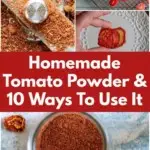
Have you ever encountered something in the kitchen where it seems like everyone knows about it except for you? And then when you find out about it, you want to share it with everyone because it’s so great. Only you’re met with, “Yeah, I know, where have you been? Welcome to the club!”
That’s me with tomato powder.
Holy cow, or as my dad always says, “Heavenly beef!” this stuff is amazing!
I’m here sharing the good news to all because I’m hoping at least a few of you have never heard of this life-changing culinary powerhouse which will make me feel better for being late to the party. In any case, you need tomato powder in your pantry.
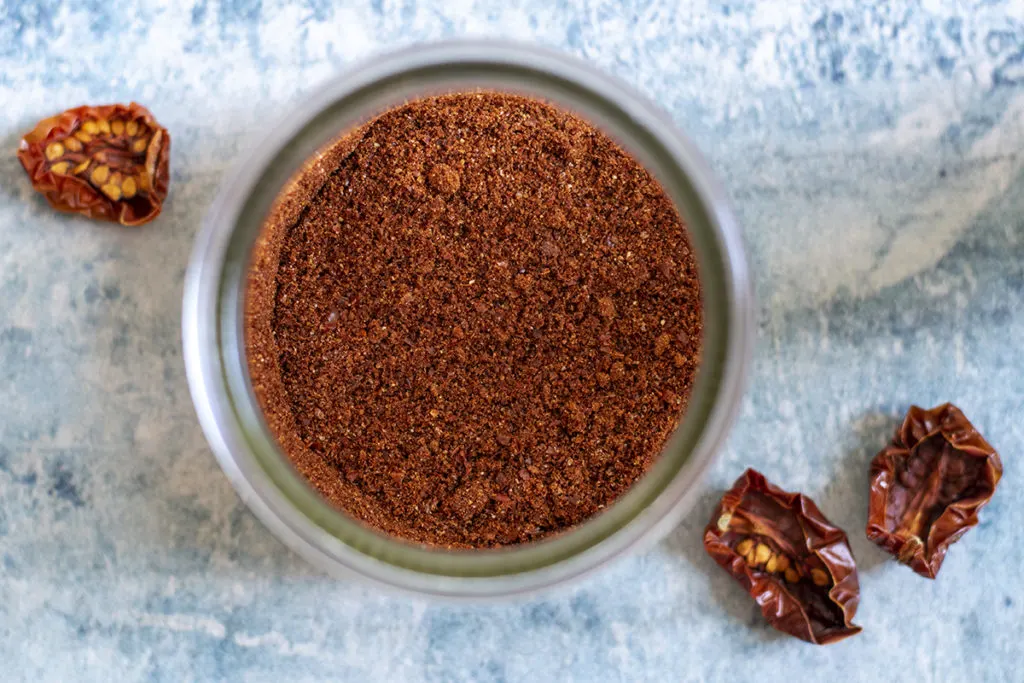
But first, let’s head out to the garden for a chat about tomatoes.
Tomato gardeners, I know you can empathize with what it’s like to be inundated with tomatoes. Very rarely do you get a couple of them at a time. When those babies start ripening, it only takes a matter of days before you’re seeing red. Everywhere.
And for those of us who like to have jars of home-canned tomatoey goodness on hand, that’s a good thing.
But what do you do when you’re still drowning in tomatoes, and you’re running out of shelf space in your pantry? Those jars of tomato sauce, tomato juice, salsa and homemade pizza sauce take up a lot of room.
If your pantry isn’t overflowing with tamotoey goodness yet, Cheryl has 26 ways to preserve tomatoes for you.
I mean, you could put up some shelving in the spare bedroom and start putting your canned harvest overflow there, but that might not be ideal when company visits.
Enter the wonder that is tomato powder.
What is Tomato Powder?
In the time it’s taken me to write this piece, I’ve made around four batches of it. And I’ve got tomato slices in the oven and the food dehydrator even now as I’m madly typing away.
Tomato powder is exactly what it sounds like. You dry tomatoes, grind them up, and you’re left with this magical tomato dust.
If you’ve ever eaten sundried tomatoes, you know that the tomato flavor becomes much sweeter and more intense. This is the same for tomato powder.
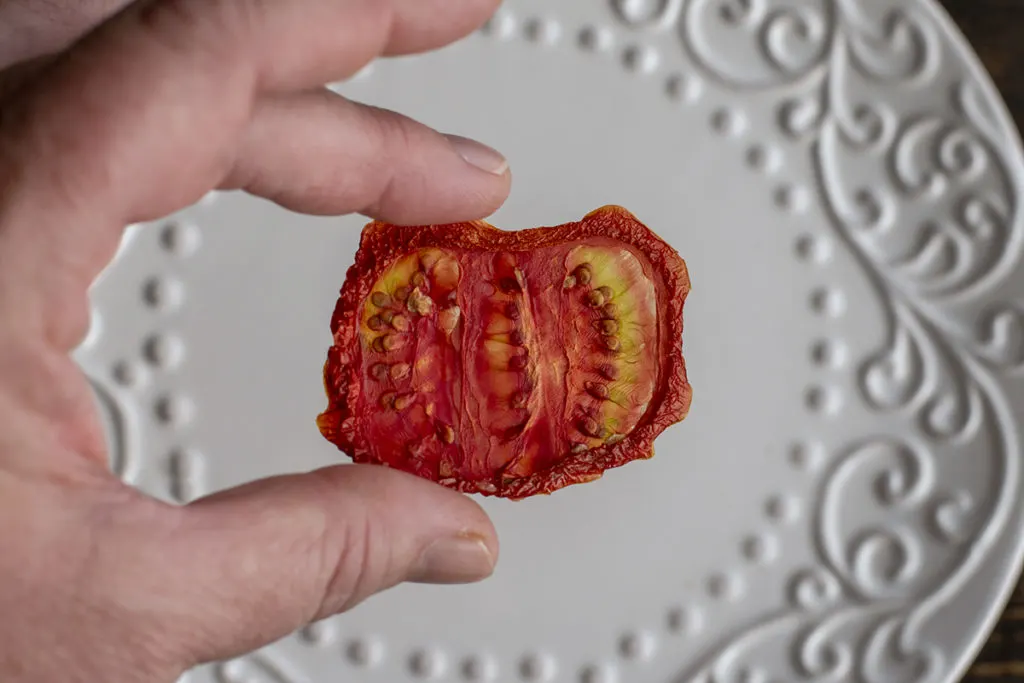
When you remove the water, the naturally occurring sugars in your tomatoes become more pronounced. The resulting tomato powder is highly concentrated in that delicious sun-ripened tomato flavor, so a little goes a long way.
This means you get lots of great tomato flavor without taking up a ton of pantry real estate.
Are you beginning to see the appeal?
Well yeah, Tracey, but what exactly can I do with this stuff?
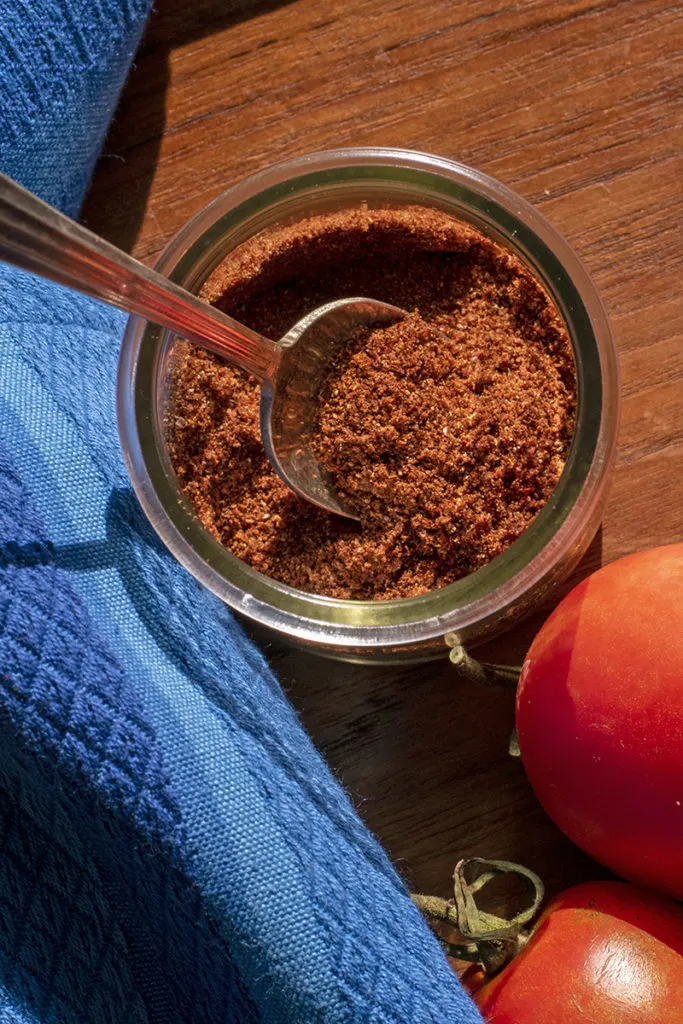
10 Ways To Use Tomato Powder
- Use it to make tomato sauce
- Mix it into your mayo to make a delicious tomato aioli.
- Make tomato paste
- Mix it into soups
- Make tomato soup with it
- Add it to dishes made with bland pink store-bought tomatoes to inject some summery tomato flavor into them.
- Mix it into salad dressings
- Use it to make your own killer dry barbecue rub
- Make homemade pizza sauce with it
- Mix it into your Bloody Mary’s to create a more intense tomato flavor
The list goes on and on. Let’s gather everything we need to make some!
What You’ll Need to Make Tomato Powder
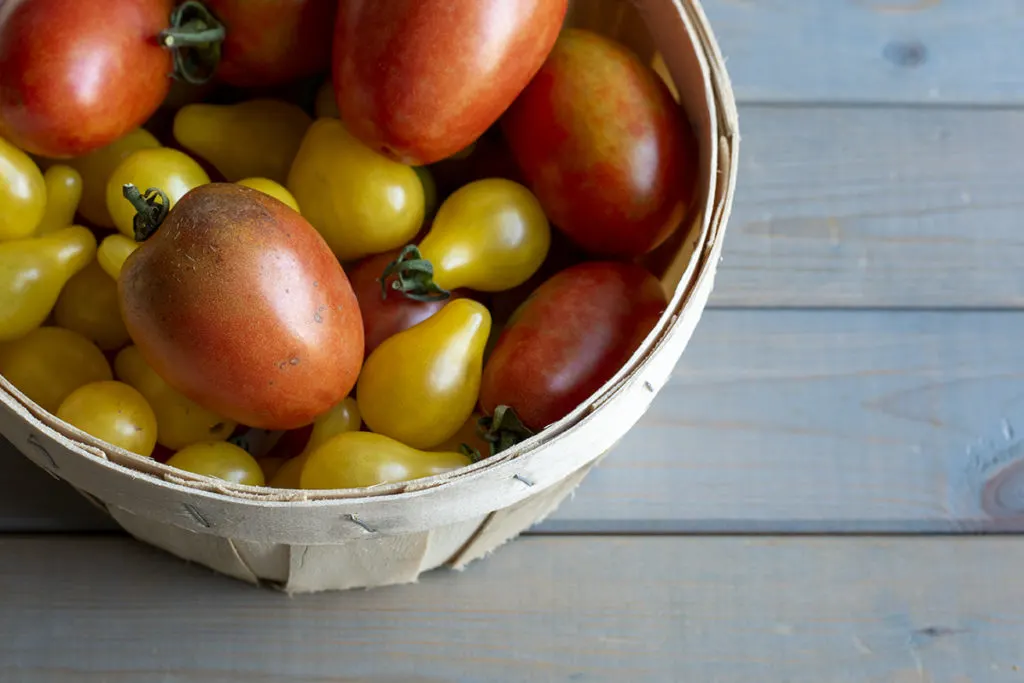
Cutting Board and Knife
You’ll want the sharpest knife you have. If you have a sharpener, I would suggest you sharpen the knife you intend to use. As every infomercial from the 90s reminds us, tomatoes are hard to slice!
Tomatoes
The best part – any type of tomato will do. If you have a hodge-podge of tomatoes hanging out on your kitchen counter, go ahead and use all of them. Using several varieties of tomatoes means you’ll get a richer flavor profile.
You know those cracked giant heirlooms that look a little worse for wear? Toss them in for a nice depth to your tomato powder. Cut out any soft spots on your tomatoes before drying them.
It’s important to note that different types of tomatoes will have more or less water in them. Larger tomatoes, such as beefsteak tomatoes, have more water and will need more time to dry. Generally speaking, your sauce tomatoes, such as Roma or Principe Borghese, are meatier and will take less time.
An Oven or Food Dehydrator
You can dry your tomatoes in the oven or with a food dehydrator. I used both methods and found they both work well with very different results.
The food dehydrator dries at a much lower temperature, preserving the bright colors of the tomatoes. With most ovens, your lowest temperature is in the 200-150 degree range. Drying at these higher temperatures darkens the tomatoes.
I noticed a big difference in flavor between the two methods as well.
Tomato powder from the tomatoes in the dehydrator had a brighter and fresher tomato flavor, while their oven-dried counterparts had a darker, sweeter flavor. It was much more in line with the flavor of sundried tomatoes. My guess is that because of the higher temperature of the oven; the natural sugars caramelize a bit. Mmm!
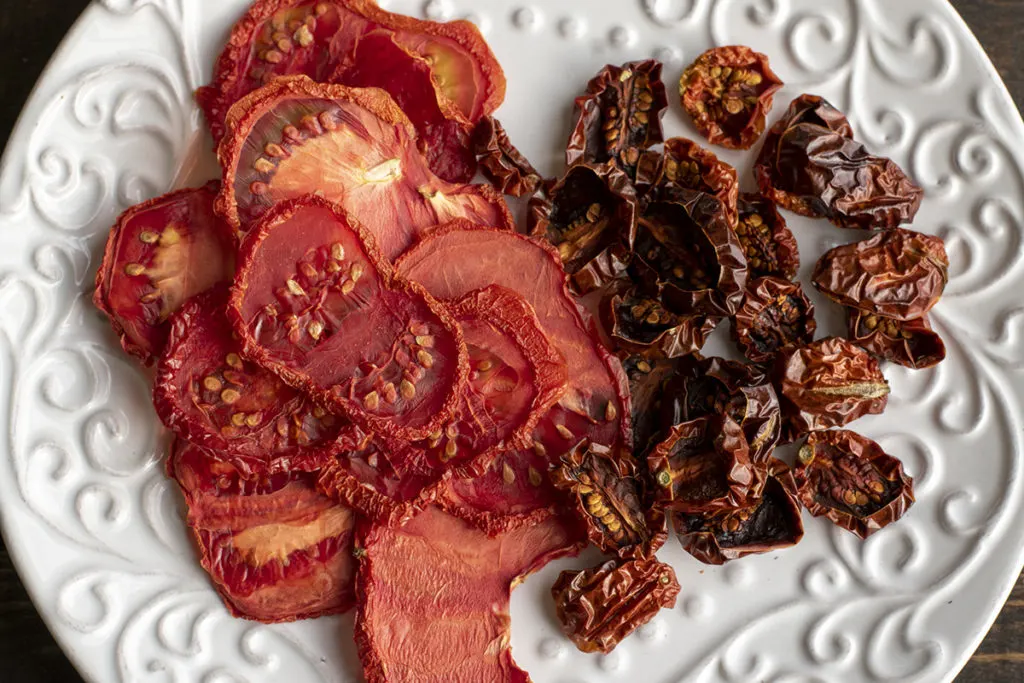
Both methods yielded wonderfully tasty results.
I ended up combining the batches to create a robust and complex flavored tomato powder. I’m making a few more batches of both to keep them separate so I can dial in the tomato flavor I want when I’m cooking.
A Blender or Food Processor or Clean Coffee Grinder
The blender and the coffee grinder yielded the finest results. (Ha, get it? Oh, come on, I haven’t made a pun in ages!) The food processor did an okay job, but I had many larger pieces left that just didn’t want to break down. I would imagine for a much larger batch, the food processor would do a better job.
Mesh Strainer
You’ll want a mesh strainer to sift your finished tomato powder through. Doing so will remove any larger pieces that didn’t get ground fine enough. You can dump those pieces back into your blender and blend them again.
Airtight Storage Container
Salt (Optional)
Not only will salt help pull any residual moisture from the tomatoes, but it is also a preservative. Not to mention it just tastes good.
Prepping the Tomatoes for Drying
We’ll begin by rinsing our beautiful tomatoes and removing their stems. Gently pat them dry with a clean kitchen towel or leave them on the table to dry. If you air-dry your tomatoes, make sure there is space between them for airflow.
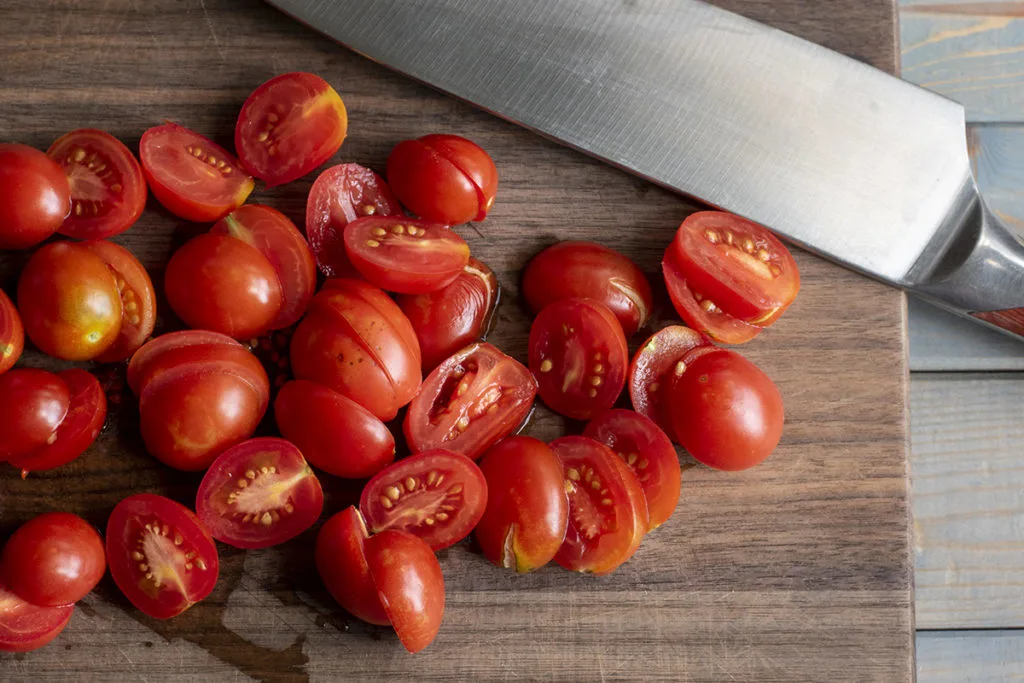
Using a sharp knife, slice the dry tomatoes as thinly as possible – ¼” is good, but 1/8″ is better. Place the tomatoes on the drying racks of your dehydrator or a metal cooling rack for the oven. Be sure to leave space between each slice for air to move.
In the oven, this is less of an issue, but good airflow is key when you’re stacking trays laden with tomatoes on top of one another in a food dehydrator.
Do not brush the racks with oil. The oil can make your finished tomato powder spoil faster or encourage mold growth. Once the tomatoes are fully dry, they will peel off of the racks quite easily.
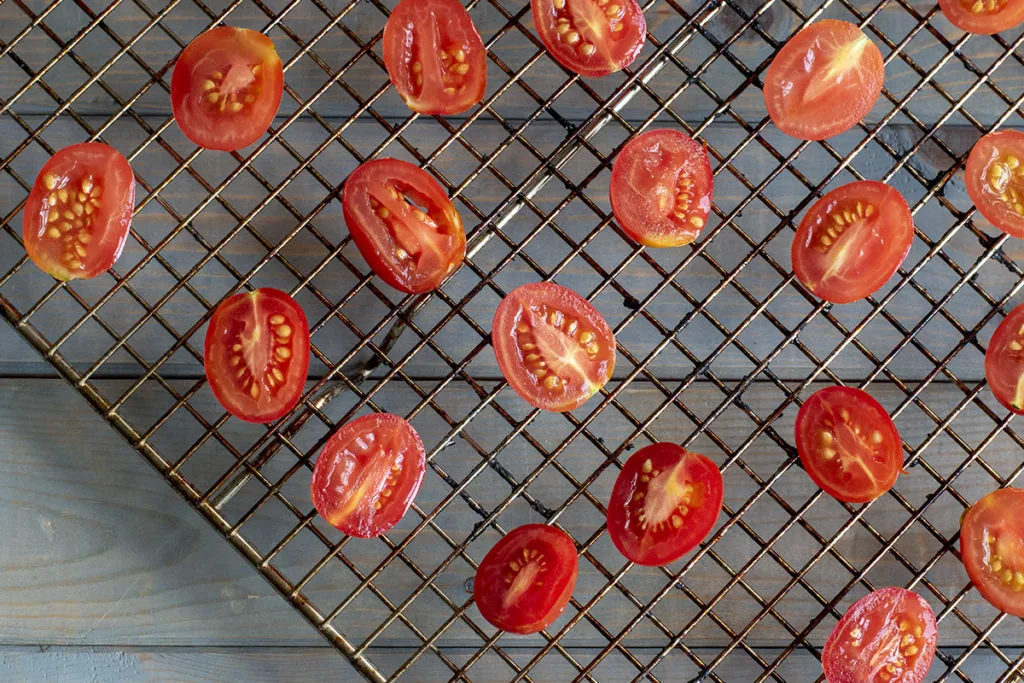
A Note About Drying Different Varieties of Tomatoes Together
As I mentioned above, different tomato varieties will need more or less time to dry, depending on their water content. You can dry them all at the same time if you wish. However, I would keep one type or one variety to each tray or rack you use. If using a food dehydrator, stack the trays with the tomatoes with the highest water content on the bottom.
You’ll also want to check your tomatoes more frequently if you’re drying several different types at the same time.
Drying Your Tomatoes for Tomato Powder
Food Dehydrator
Set your dehydrator between 120-140 degrees if you have one that allows you to adjust the temperature. You want to keep the temp around the mid-range of most dehydrators. This will preserve the color of the tomatoes.
Drying tomatoes in the food dehydrator does take longer, but depending on the finished result you’re after, the resulting tomato powder is more reminiscent of fresh tomatoes.
Oven
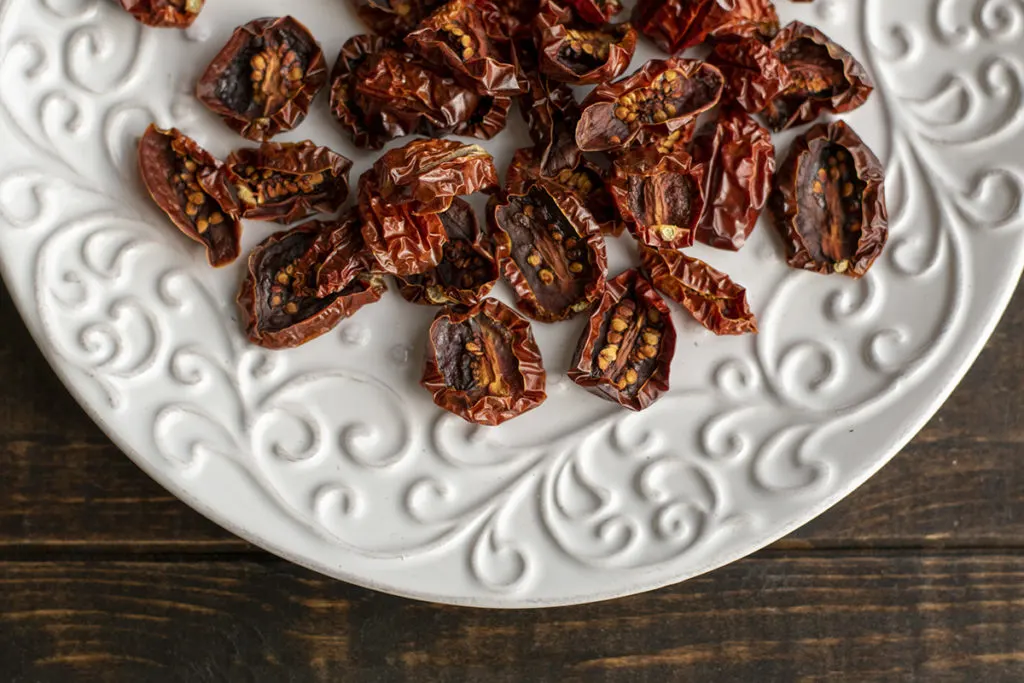
If you’re drying your tomatoes in the oven, set it to the lowest temperature it will go. If the lowest temperature of your oven is higher than 170 degrees, I would suggest using a wine cork or wooden spoon to keep the door propped open a little. This will keep the internal temperature from getting too hot and vent any moisture from the drying tomatoes.
If your oven has an internal fan, you might want to use that as well to aid in moving the warm air and venting the moisture.
When Are My Tomatoes Done?
It’s important to make sure all of the moisture is removed from the tomatoes, or you can risk mold or early spoilage of your tomato powder.
A simple test will tell you when your tomatoes are completely dry.
Bend a tomato slice; if it’s completely dry, it should be brittle and snap in two. It should not give or bend or feel leathery. If it does, there is still moisture in the tomatoes, and they need to go for a while longer.
How Long Will it Take?
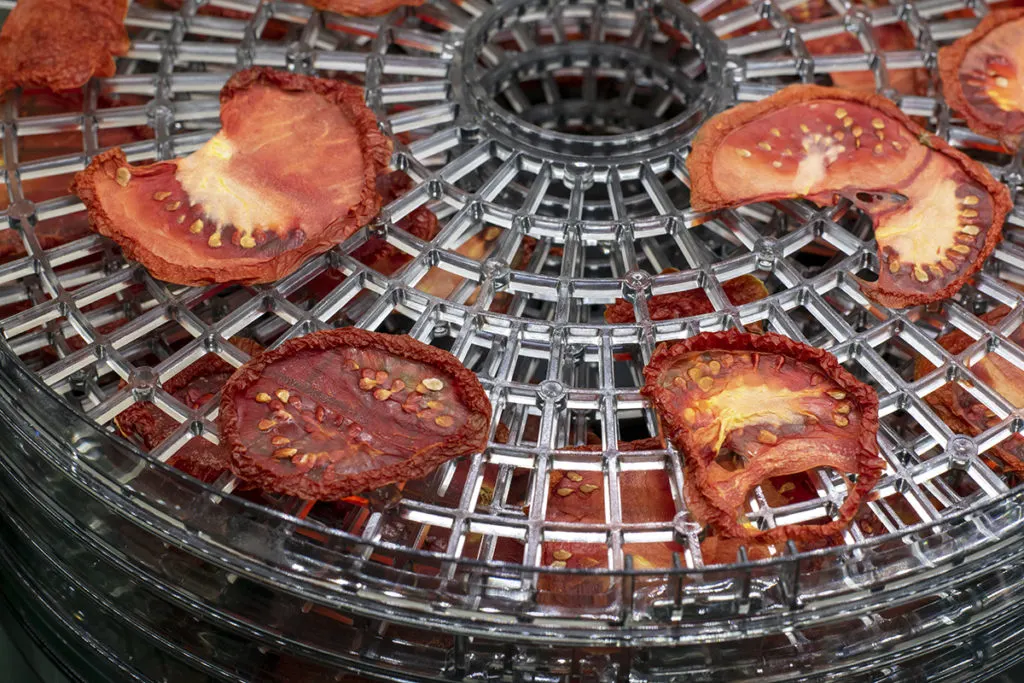
Boy, your guess is as good as mine.
My batches have varied in time from 8 hours to 32 hours. There are several different factors in play that will impact how long it takes for your tomatoes to become completely dry.
The thickness of the slices, the initial moisture content of the tomato, the temperature with which you dry them, and even the relative humidity in your home all factor into how long it will take.
A good rule of thumb is to start checking your tomatoes around the five-hour mark. At this point, you can gauge whether or not they are getting close or will need quite a bit more time.
It’s important to remember that because of the oven’s higher temperature, your tomatoes will always dry faster than in a food dehydrator. If you’re going to dry tomatoes this way, I suggest checking back often after that five-hour mark.
Tomatoes left in the oven can burn and get bitter if you leave them in too long.
Using a food dehydrator to dry the tomatoes at a lower temperature gives you a lot more wiggle room and doesn’t need to be checked as often.
Once your tomatoes are done, let them cool completely before grinding them.
Grinding the Dried Tomatoes Into Tomato Powder
Using your blender or food processor, add the tomatoes and pulse a few times to break down the slices into pieces. Now go to town and blend or process away.
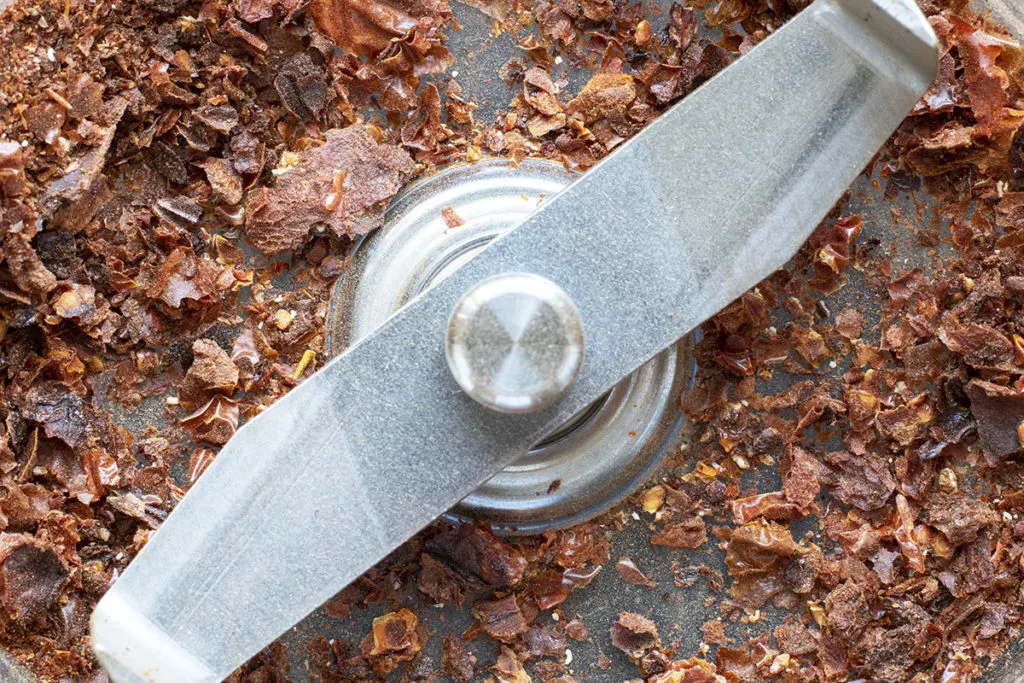
Don’t be surprised if the tomato powder tends to stick to the sides a bit. (Yay, static electricity!) Just stop for a moment and give the sides of your container a good thump with a rubber spatula to knock the powder from the sides.
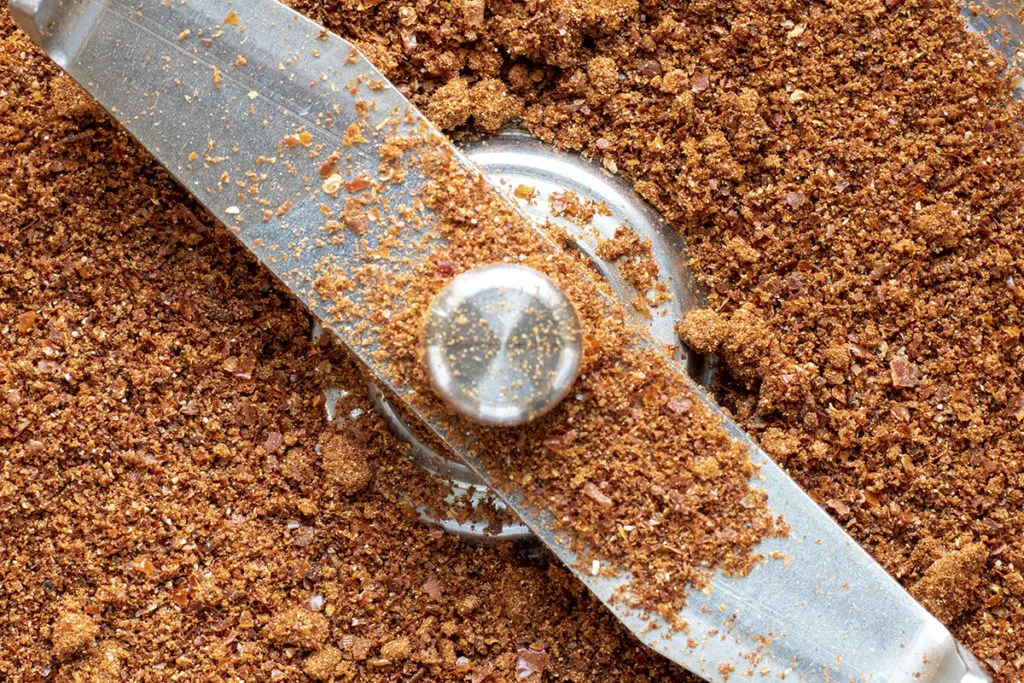
Sifting the Tomato Powder
Once you’ve got a nice pile of powder, sift it through a mesh sieve to separate the larger pieces. Now you blend those again until they are all powdered.
Storing the Tomato Powder
As I mentioned initially, you may wish to add a bit of salt to your tomato powder for flavor and to help preserve it. How much is really up to you, but I added ¼ tsp for every ¼ cup of tomato powder.
Try a batch with salt and a batch without to see which one you enjoy most.
Use a funnel to pour your tomato powder into an airtight jar. Store your tomato powder someplace cool and dry, and it will last for several months.
To really stretch your tomato powder, vacuum seal your batches and store them in the freezer, transferring them to an airtight jar as needed. Frozen like this, the tomato powder will last almost indefinitely.
How Much Does It Make?
It’s tough to judge how much finished powder you’ll end up with for the same reason it’s hard to judge how long it will take to dry.
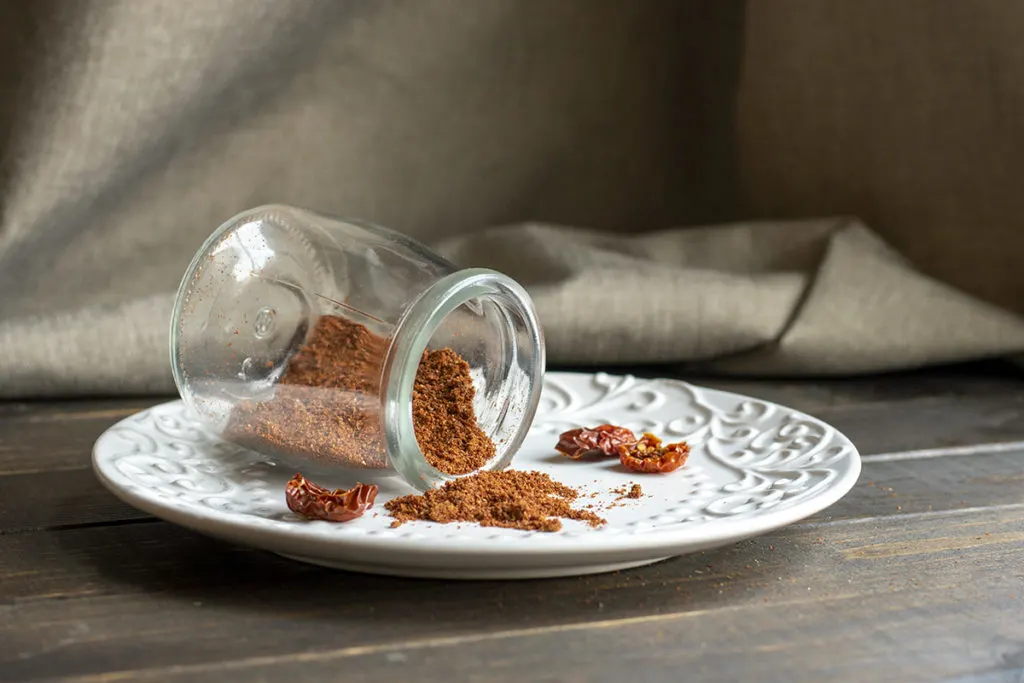
I dried 20 cherry tomatoes and ended up with ¼ cup of tomato powder. For another batch, I dried six medium-sized beefsteak tomatoes and ended up with just under ½ cup of powder.
If you’re aiming for a specific amount, my advice would be to keep making batches of tomato powder until you reach the desired amount.
Using Tomato Powder
It’s important to remember that a little goes a long way with this stuff. The flavor is wonderful and packs a lot of tomato into a tiny amount. Unless you’re following a recipe that calls for a specific amount of tomato powder, I would start with ¼ to ½ a teaspoon and add more if you need it.
Once you’ve made a few batches, you’ll see how easy it is to make.
And the great thing is, if you go crazy as I did and make batch after batch, you won’t be stuck trying to figure out where to put it all.
If you’re still drowning in ripe tomatoes, here’s 15 Terrific Ways to Use a Ton of Tomatoes!
And we’ve got you covered for all of those end of season green tomatoes too – 21 Green Tomato Recipes For Using Unripe Tomatoes
Now, if you’ll excuse me, I have a BLT to make.
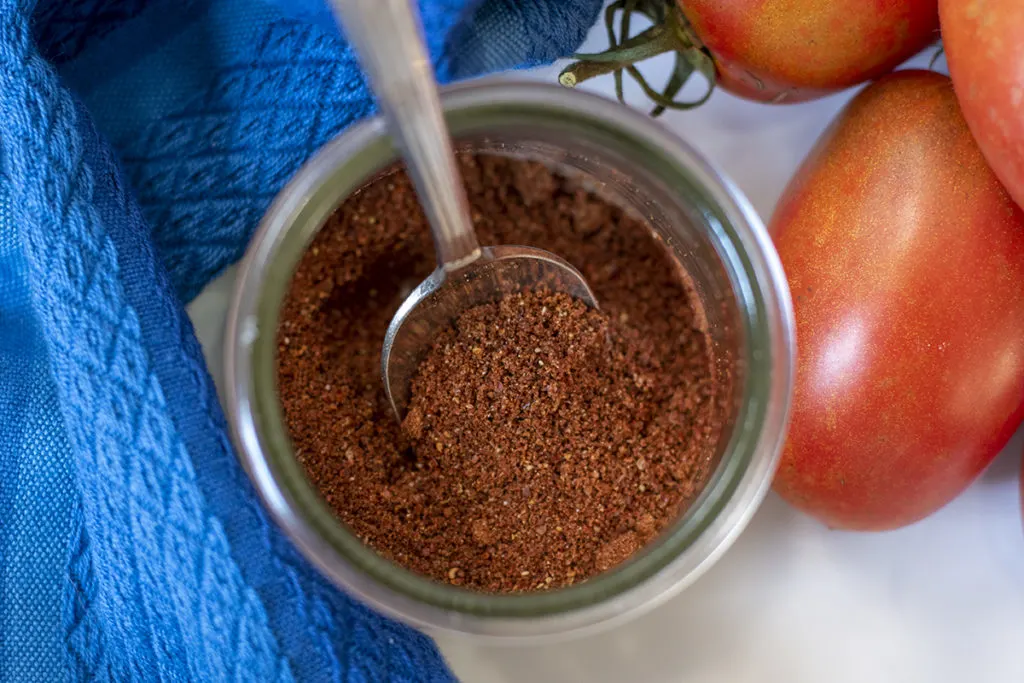
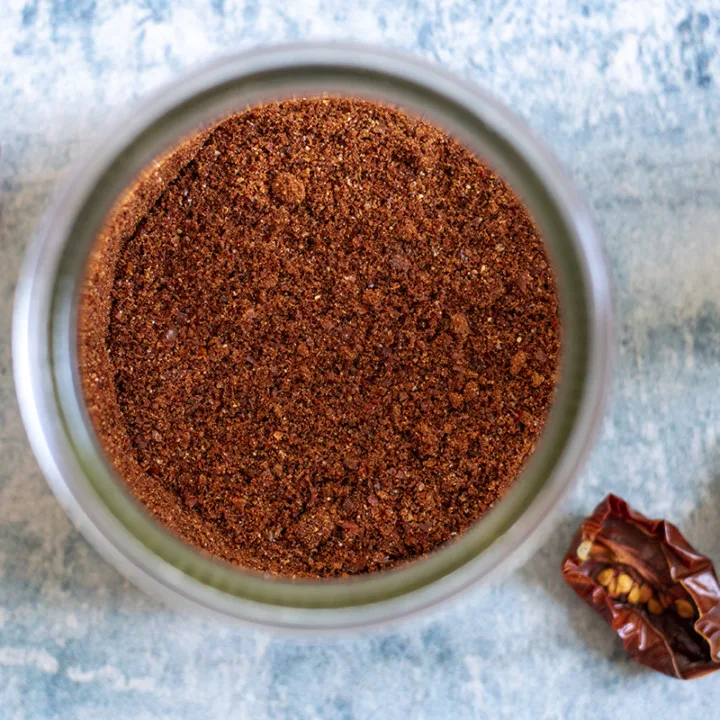
Homemade Tomato Powder
Tomato powder is exactly what it sounds like. You dry tomatoes, grind them up, and you’re left with this magical tomato dust.
Ingredients
- Tomatoes
- Salt (optional)
Instructions
- Slice your tomatoes as thinly as possible.
- Space your tomato slices on a rack in the dehydrator at 120-140F. Alternatively, place in your oven at the lowest temperature it will go.
- After 5 hours, check on your tomato slices. You'll want the slices to be completely dry. When you try to bend them, you'll want them to snap like a crisp, not bend. If they are not dry yet, place back in the oven or dehydrator and check again an hour later.
- Once completely dry, add your dried slices to a blender or food processor and blend or process until you are left with a fine powder.
- Sift through a mesh sieve to separate the larger pieces and then blend the larger pieces again.
- Pour your tomato powder into an airtight container for storage. Optionally, add salt to preserve for longer and add flavor. I recommend 1/4 tsp for every 1/4 cup of tomato powder.

Get the famous Rural Sprout newsletter delivered to your inbox.
Including Sunday musings from our editor, Tracey, as well as “What’s Up Wednesday” our roundup of what’s in season and new article updates and alerts.


